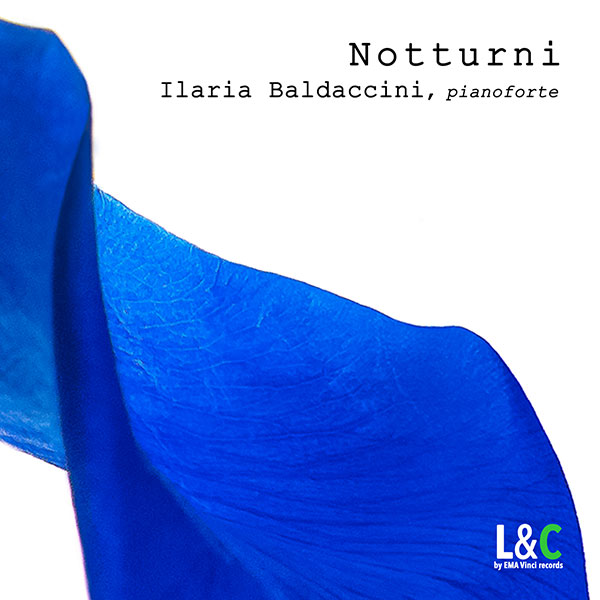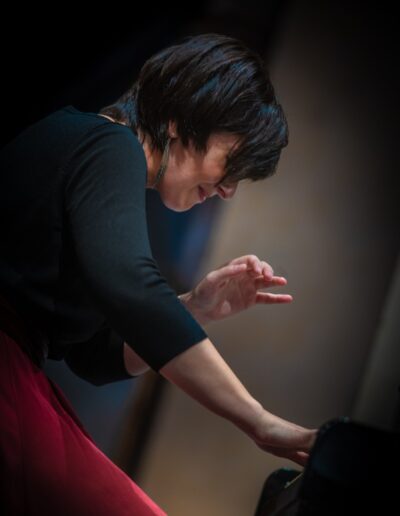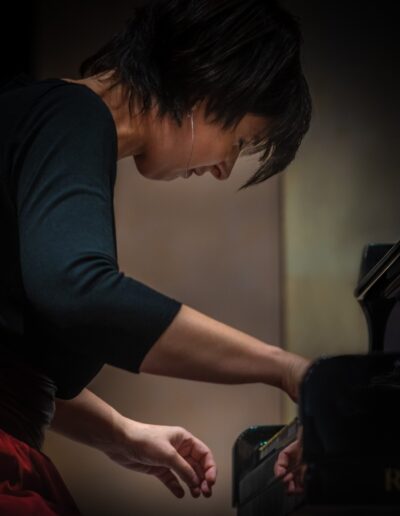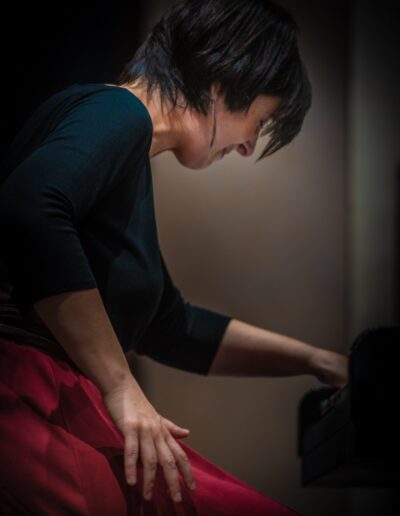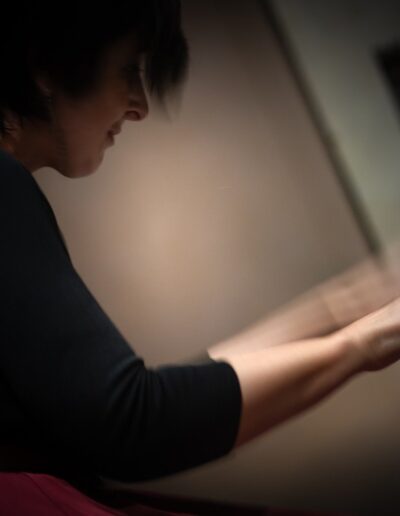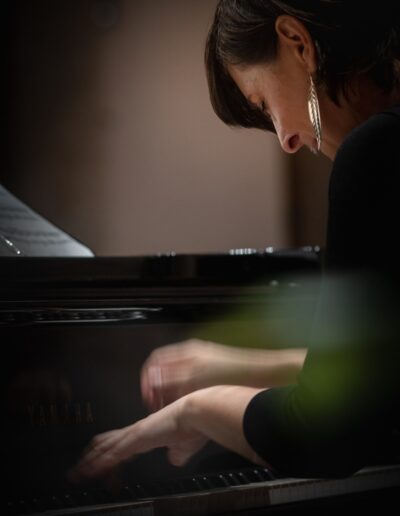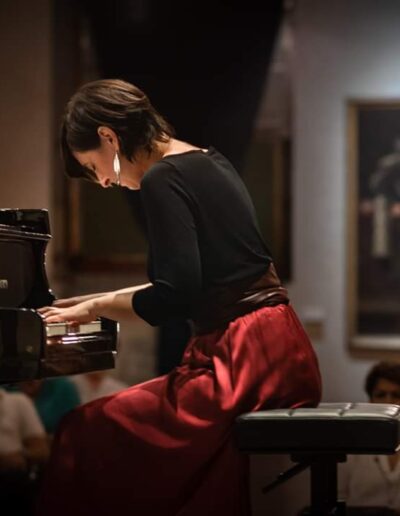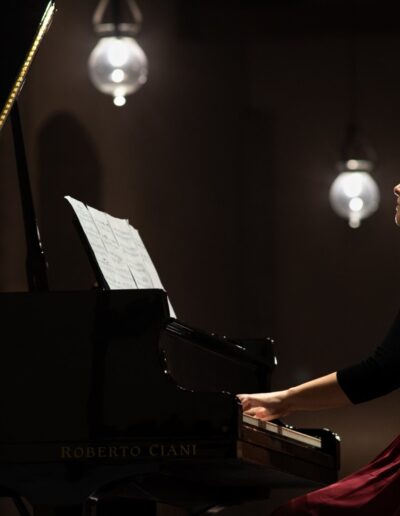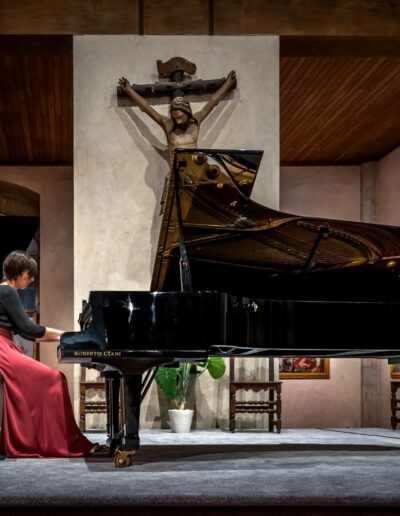‘Fermarsi, e riflettere. Fermarsi e andare piano, come elogio alla lentezza. Fermarsi e gustare la notte, il silenzio, la pausa e tutto ciò che la vita intorno a noi crea di notturno: ascoltare il notturno come forma musicale e struttura poetica: questo il CD di Ilaria Baldaccini che propone al pianoforte tale nota e speciale formula compositiva che ha attraversato i tempi importanti di questi ultimi tre secoli. Senza però indugiare solo sul passato, ma andando a soppesare i misteri della scrittura moderna: oltre a Chopin giungere ad Arduino Gottardo che scrive per la Baldaccini il suo brano del 2020; oltre a Bartòk esplorare Montalbetti, Galante, Poulenc. Notturni, dunque: in tutte le declinazioni.’
Anna Menichetti per Radio Svizzera Italiana, 30 settembre 2021
‘La notte scende sulla tastiera e porta con sé la meraviglia paurosa del buio con qualche brillio di stella. “Notturni” è il cd a tema che la pianista Ilaria Baldaccini ha registrato alla Certosa di Firenze durante il lockdown del dicembre 2020 intrecciando pagine fresche d’inchiostro ad altre piuttosto recenti e ad altre ancora ottocentesche e del Novecento storico’
Gregorio Moppi, La Repubblica, 20 settembre 2021
‘Non più un autore ma un’idea, musicale e non. Notturni (Ema Vinci) è un album in cui la pianista Ilaria Baldaccini esplora le possibilità tra i contemporanei di trovare vita e significato in una forma musicale esaltata dal romanticismo. Una sottilissima interpretazione di Prima Stanza di Osvaldo Coluccino è la perla della raccolta.’
Mario Gamba, il manifesto, 22 gennaio 2022
| 1 | Girolamo Deraco | Alea notturna (2013) |
| 2 | Béla Bartók | Notturno da Mikrokosmos Vol. 4 (1926/1939) |
| 3 | Daniele Venturi | BCH (2011) |
| 4 | Arduino Gottardo | Nocturne per fauno (2020) * |
| 5 | Fabrizio De Rossi Re | Nightfall (2019) * |
| 6-8 | Carlo Galante | 3 Intermezzi alla notte (2002) La lingua di ferro della mezzanotte batte dodici volte Recitativo con cielo stellato Danza dell’inquieto plenilunio |
| 9 | Osvaldo Coluccino | Prima stanza (2004) |
| 10 | Mikhail Glinka | Notturno in fa minore La Séparation (1839) |
| 11 | Pyotr Ilyich Tchaikovsky | Notturno in do diesis minore, dai sei pezzi Op. 19 (1873) |
| 12 | Francis Poulenc | Notturno Les cloches de Malines (1934) |
| 13-14 | Mauro Montalbetti | Deux Nocturnes, au jeu des éphémères (2019) ** |
| 15 | Frédéric Chopin | Notturno in do diesis minore Op.Post. (1830) |
*Opera scritta per Ilaria Baldaccini e a lei dedicata
**Opera commissionata con il sostegno di Siae-Classici di Oggi ed. 2018-2019 e dedicata a Ilaria Baldaccini. Incisione del manoscritto.
Disco registrato presso la Certosa di Firenze nel dicembre 2020. Yamaha C7 – Bonechi Pianoforti.
1
Girolamo Deraco
Alea notturna (2013)
2
Béla Bartók
Notturno da Mikrokosmos Vol. 4 (1926/1939)
3
Daniele Venturi
BCH (2011)
4
Arduino Gottardo
Nocturne per fauno (2020) *
5
Fabrizio De Rossi Re
Nightfall (2019) *
6-8
Carlo Galante
3 Intermezzi alla notte (2002)
La lingua di ferro della mezzanotte batte dodici volte
Recitativo con cielo stellato
Danza dell’inquieto plenilunio
9
Osvaldo Coluccino
Prima stanza (2004)
10
Mikhail Glinka
Notturno in fa minore La Séparation (1839)
11
Pyotr Ilyich Tchaikovsky
Notturno in do diesis minore, dai sei pezzi Op. 19 (1873)
12
Francis Poulenc
Notturno Les cloches de Malines (1934)
13-14
Mauro Montalbetti
Deux Nocturnes, au jeu des éphémères** (2019)
15
Frédéric Chopin
Notturno in do diesis minore Op.Post. (1830)
*Opera scritta per Ilaria Baldaccini e a lei dedicata
**Opera commissionata con il sostegno di Siae-Classici di Oggi ed. 2018-2019 e dedicata a Ilaria Baldaccini. Incisione del manoscritto.
Disco registrato presso la Certosa di Firenze nel dicembre 2020. Yamaha C7 – Bonechi Pianoforti.
Dark Night, Bright Stars
by Renzo Cresti
In the archaic Hellenic culture of Orphism, Night was imagined as a big black bird that after being fertilized by the Wind laid a silver egg, from which Eros was born. To these symbolic characters are connected others, such as Thanatos (Death), Hypnos (Sleep), the Moirai (daughters of Night), the Fatum (Oracle)…. So many relationships can be created beginning with the Night! The hour of midnight, then, represents the moment when anything may occur, the natural and the supernatural, magic and witchcraft, the exceptional and the monstrous. It is also the hour when humans are focused on themselves, meditating on their destiny, where the dreams, the unconscious, and the darkness within us take over. Night is also connected to the theme of Nature and to its sublime moments, as in the so-called Ossianic poetry. All Romantic art well explained these relationships with the Night, long before Freud, who at the beginning of the twentieth century codified the drives in a precise discipline, that of psychoanalysis, which successively underwent many variants and great success. But the night is also the enchanted moment of love songs, where the stars are luminous and illuminate the emotions. Ilaria Baldaccini’s idea of dedicating this piano anthology to such a central theme is very interesting and evocative.
For the Romantik Night was the black shroud enveloping torments and passions, moments at times poignant, anguished, passionate, tormented, or pathetic. There was no need to add exemplary titles. For the Romantics, the nocturnes were travel companions towards a psychic place different from that of the day. It is not by accident that the piece by Chopin, the only composer from the Romantic period with Glinka, bears only the number of the work. Even for Tchaikovsky and Bartók there is no need to give a title; the nocturnal music is expressive in itself. The formulation changes with Poulenc (the French Night is less menacing than the German) and still more with the recent and Italian composers (the Italian Night is Mediterranean). Besides the more or less explicit references to Chopin (Montalbetti) and Britten (De Rossi Re), Night becomes aleatory (for Deraco), connecting itself to the Fates, then baroque with an entranced Bach (by Venturi), crepuscular (Gottardo), silent (Coluccino), starry and restless (Galante), in a variety of concepts of Night, referring to the stylistic multiplicity of this album.
The anthology is intentionally heterogeneous, a voyage through history and geography following one of the fundamental universal themes of all cultures, presented here in a variety of Western interpretations. Ilaria Baldaccini’s musical projects are always precise and each of her cds is related to a wide-ranging project, such as her rediscovery of composers who either came from or worked in Florence, principally at the Cherubini Conservatory. Too often we still find cds edited without any criteria except for choosing pieces that the performer knows best. Fortunately, Baldaccini always gives us programmes with compositions that are well connected to each other. The historical interconnections, stylistic crossroads, and thematic interlacing that we hear in this beautiful cd provide us with a map of the creativity that the Night has always evoked.
Baldaccini has already, frequently, given us proof of her bravura, often in recordings for Vinci Records. This is not only because of her performance skill, though this is fundamental, but also because of her intelligence in selecting and organizing the pieces and for the sensitivity of her interpretation. And in this case considerable sensitivity has been called for, considering that the composers are diverse historically, culturally, and stylistically, each with their strong personality. Baldaccini is excellent at tying together all the phases of her voyage; tout se tient (it all fits together). The delicacy of her touch predominates, albeit moments of excitability are not lacking, giving us the sentiment of the Night, differing in its transformations but uniform in the totality of emotions that Baldaccini offers us through her participation, entering into it and piercing the expressive heart of each piece that she interprets.

